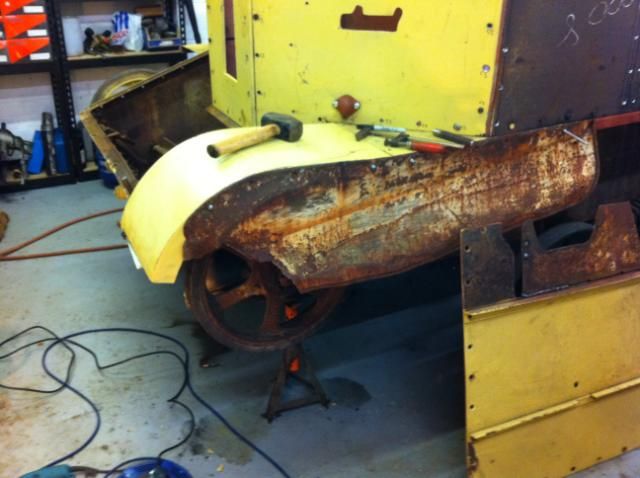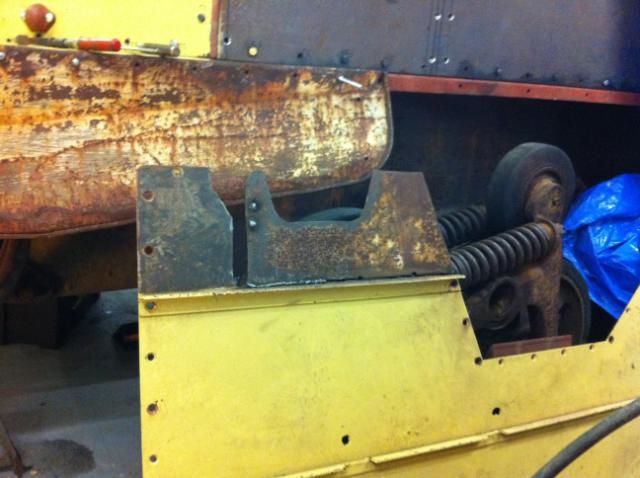
 |
|
|
|
#1
|
|||
|
|||
|
I have used 4140. It work hardens. I used steel from broken shafts that were so hard, at the break, that a ceramic tip wouldnt put a mark on them.
I made mine on the lathe and finished them off with a die grinder. (my formal lathe training was mostly while the metalwork teacher wasn't looking at school) The small one, with the handle was rolled into place behind the rivet head to do the ones going through the engine bed rails into the floor. (we are yet to do the second one) We have done them with the carrier on its side, introducing a dolly behind the handled thing.(on the outside of the bed rail) If you are planning this operation, look for a friend who is an insect, or even better a spider. If you ask your wife, she might point you in the direction of one of her ex boyfriends. Anyhow the point is, they need extra arms/hands etc. We have cut the rivets to length for each set of rivets. I heat a rivet, pick it up with pliers, and poke it into the hole. My friend with the gun pulls it in while I position the dolly. I yell "ready" or "go" (this is optional. I'm sure Richard, that you will have some weird local alternative) With that heavy dolly arrangement in the photo, I get it behind the rivet,get my knee behind my elbow, and my foot against the inside of the hull on the opposite side. It works good that way. Try not to put rivets in the bolt holes for the bogie adjusting studs. They look good, but slows your progress down.
__________________
Bluebell Carrier Armoured O.P. No1 Mk3 W. T84991 Carrier Bren No2.Mk.I. NewZealand Railways. NZR.6. Dodge WC55. 37mm Gun Motor Carriage M6 Jeep Mb #135668 So many questions.... |
|
#2
|
|||
|
|||
|
Hey guts you don't have to heat the rivets they will peen in cold
Just a little experience talkin : |
|
#3
|
|||
|
|||
|
The hot rivet is firstly spread laterally in the hole to take up any discrepancies, the head and tail are then formed, and then as the rivet cools it shrinks tightening the whole deal up. If your going to put them in cold, you may as well use a bolt. According to one web site, "A bolt is just a low grade rivet"
And no! my gun (as big as it is) wouldn't form them cold.
__________________
Bluebell Carrier Armoured O.P. No1 Mk3 W. T84991 Carrier Bren No2.Mk.I. NewZealand Railways. NZR.6. Dodge WC55. 37mm Gun Motor Carriage M6 Jeep Mb #135668 So many questions.... |
|
#4
|
||||
|
||||
|
Lynn they will be put in hot, i was just interested to see what it would do to a cold rivet
__________________
is mos redintegro __5th Div___46th Div__ 1942 Ford Universal Carrier No.3 MkI* Lower Hull No. 10131 War Department CT54508 (SOLD) 1944 Ford Universal Carrier MkII* (under restoration). 1944 Morris C8 radio body (under restoration). |
|
#5
|
||||
|
||||
|
Well another few hours in the garage tonight with Jnr. managed to pull the glacis plate and offer up one repro fender.... i have used the original sand guards to form a datum when offering up the new fenders to drill them.. the original sand guards and the original fenders are in a bad way, bud salvageable so will get restored when the carrier is done and kept as spares.
  Now to the glacis plate you will notice that the missing top section is being "Pieced" back in.. the question on most minds would be "why not make this from one new bit and weld it in ?" well i have off-cuts of original 5mm steel from the division plate, which i kept back to re introduce back onto the carrier all be it in a different place... i suppose a romantic notion that i want to retain as much original fabric that i can. when its done it will look like it never left the carrier. I suppose it could be argued that i should not have removed it from the remains of the division plate in the first place, hind sight is...yes your right but at the time i did the division plate i was less confident of offering the new steel up to the original stuff, it was easier for me to use the track guards as a datum and run fresh steel above that line.....  i still have some countersinking to do on the front but the bit snapped tonight so will need to get another this week.
__________________
is mos redintegro __5th Div___46th Div__ 1942 Ford Universal Carrier No.3 MkI* Lower Hull No. 10131 War Department CT54508 (SOLD) 1944 Ford Universal Carrier MkII* (under restoration). 1944 Morris C8 radio body (under restoration). |
|
#6
|
|||
|
|||
|
keep it as original as you can
 rick
__________________
_______________________ 1941 mk1 mortar Carrier 1941 Mk1* Carrier 1942 Mk1* Carrier 1943 T16 Carrier 1945 Mk3 Dingo 1941 Mk3 Covenanter 1941 Mk4 Churchill AVRE (now sold) 1944 Mk6 Cromwell (now sold) 1952 Mk3 Centurion 1952 ARV Centurion 1952 ARV Centurion 1953 Mk3 Centurion (breaking) |
|
#7
|
|||
|
|||
|
When a rivet is put in hot it will shrink when it cools, but a rivet is a rivet
Just figure out the torque presure on a nut and bolt then figure out the torque pressure on a hammered rivet no comparrison. The bolt wins there is a good chance when Ford manufactured the carrier the rivets where not put in one at a time there for eliminating time and man power Now I am just stirring the pot |
 |
| Thread Tools | |
| Display Modes | |
|
|